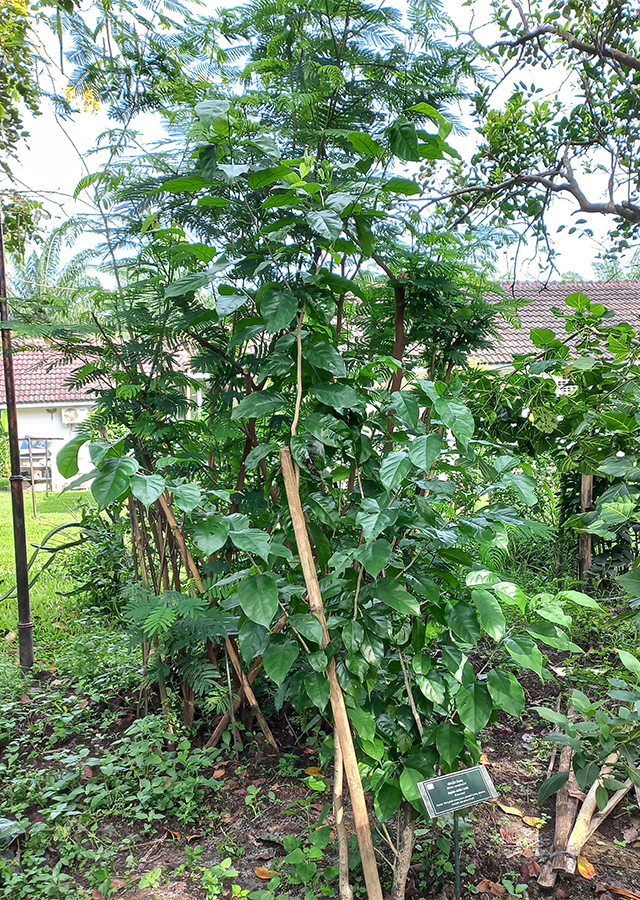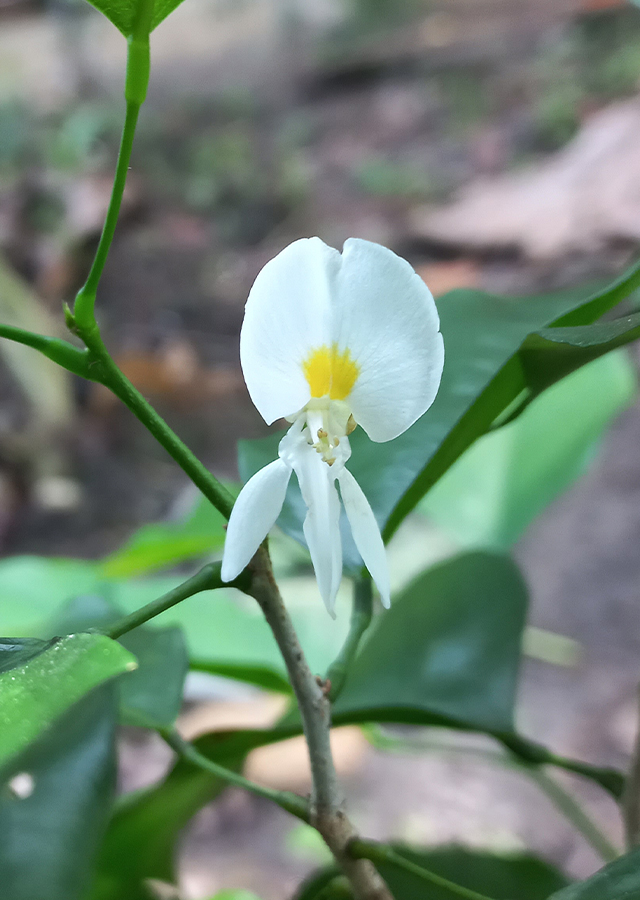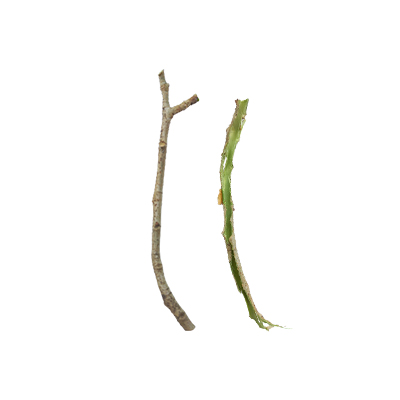Camwood
Baphia nitida G.Lodd.
Fabaceae
Location in our garden
Green House



Synonym
Baphia barombiensis Taub.
Baphia haematoxylon Hochst. ex Hook.
Baphia pyrifolia (Desv.) Baill.
Habitus
Shrubs. A many-stemmed erect shrub or small tree growing from 2.5 - 10 m tall
Part Used
Leaves
Bark
Roots
Stem
Growing Requirements
Full Sunshine
Habitat
Forest
Terrestrial
Overview
Baphia nitida occurs wild from Senegal to Gabon. It is often cultivated near villages, formerly as a dyewood especially in Sierra Leone and Liberia, now more often as an ornamental shade tree or as fence and hedge. In some regions the tree is considered sacred, endowed with the power to protect against evil spirits and to attract benevolent ones. Widespread in west Africa, there are no major threats to this species at present. However, it is largely utilized locally throughout its range as a source of building materials, for making dye, in folk medicine and as a cosmetic, therefore the species should be monitored in the future to make sure of the status and health of the populations. It is classified as 'Least Concern' in the IUCN Red List of Threatened Species(2011).
Vernacular Names
Bois de cam (French).
Agroecology
A plant of the moister lowland tropics, where it is found at elevations up to 600 m. It grows best in areas where annual daytime temperatures are within the range 24 - 30 °C, but can tolerate 16 - 32 °C. It prefers a mean annual rainfall in the range 1,500 - 2,400 mm, but tolerates 1,300 - 4,500 mm. Prefers a position in full sun, tolerating light shade, in a fertile, medium-textured soil and pH in the range of 5 - 5.5, tolerating 4.5 - 7.
Morphology
- Stems - erect shrub or small tree up to 9 m tall with glabrous to densely pubescent branchlets.
- Leaves - alternate, simple and entire; stipules quickly caducous; petiole 1–4 cm long, prominently thickened at base and at top; blade ovate, elliptical, obovate or lanceolate, 5–21 cm × 3–9 cm, base rounded to cuneate, apex acuminate, slightly leathery, almost glabrous, pinnately veined.
- Flowers - axillary fascicles, 1–5-flowered, bisexual, papilionaceous; pedicel slender, 3–17 mm long; calyx spathaceous, 8–10 mm long, glabrous but with a tuft of brown hairs at apex; corolla with standard suborbicular, 1–2 cm in diameter, white with a yellow centre, wings and keel white with a pocket near the base; stamens 10, filaments unequal, free, up to 7 mm long; ovary superior, sessile, glabrous, sometimes with a row of silvery hairs along the dorsal margin, 1-celled, style curved, filiform, stigma small.
- Fruits - compressed pod 8–16.5 cm × 1–1.5 cm, pointed at both ends, 1–4-seeded.
- Seeds - almost circular in outline, 1–1.5 cm in diameter, brown.
Cultivation
Camwood is easy to cultivate and can be propagated by seeds and cuttings. For best results cuttings should be taken from rather young parts.
Chemical Constituents
Saponins, flavonoid glycosides, tannins, baphic acid, baphiin, deoxysantarubin, homopterocarpin, maackiain, pterocarpin and santal.
Traditional Medicinal Uses
- An ointment made from the leaves has showed anti-inflammatory activity, supported the external use in traditional medicine.
- Extracts of fresh leaves inhibited digestion, showed antidiarrhoeal effects and also demonstrated analgesic activity.
- An infusion of the leaves is drunk to cure enteritis and other gastrointestinal problems.
- The powdered leaves are taken with palm wine or food to cure venereal diseases. Combined with Senna occidentalis, it is drunk against asthma; in combination with the leaves of Morinda lucida it is a treatment against female sterility and painful menstruation.
- A decoction of the leaves is taken against jaundice and diabetes. The leaves have also been used as an enema to treat constipation.
- The leaves or leaf juice are used externally against parasitic skin diseases. Combined with Cissus quadrangularis, it is used to treat bone fractures.
- Both leaves and bark are considered haemostatic and anti-inflammatory, and are used for healing sores and wounds.
- A bark decoction is drunk to cure epilepsy and cardiac pain.
- The powdered heartwood is made into an ointment with shea butter (Vitellaria paradoxa) and is applied to stiff and swollen joints, sprains and rheumatic complaints.
- Finely ground root bark, mixed with honey, is taken against asthma.
- The pounded dried root, mixed with water and oil, is applied to a ringworm-like fungus attacking the feet.
Part Used
Reference Sources
- Fern, Ken. Useful Tropical Plants. (2021). Baphia nitida. https://tropical.theferns.info/viewtropical.php?id=Baphia+nitida. 11-09-21.
- Plant Resouces of Tropical Afica. Baphia nitida. https://uses.plantnet-project.org/en/Baphia_nitida_(PROTA). 11-09-21.


